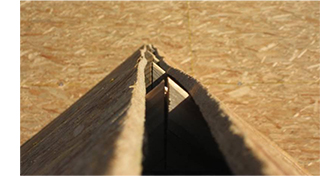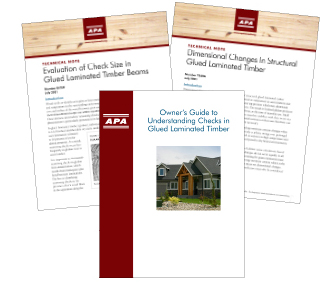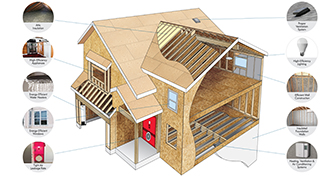July 2021

Note: Due to Covid-19 control measures, we are unable to fulfill orders of printed publications at this time. These publications are available as downloadable PDFs.
PROBLEM SOLVER
 Common Framing Problems
Common Framing Problems
After decades of site inspections, we have seen hundreds of examples of wood-frame construction errors contributing to complaints and callbacks. To help solve these problems, we have compiled and explained the most frequent framing complaints and their causes, linking to publications that provide further details on methods of prevention and solution. We've answered questions like:
• Why are my walls or roof wavy?
• Why are my floors noisy?
• Can I put holes in engineered wood beams or I-joists?
• and more.
See the entire list of solutions. GO >
UPDATED GLULAM PUBLICATIONS
 Owner's Guide to Understanding Checks in Glued Laminated Timber
Owner's Guide to Understanding Checks in Glued Laminated Timber
In commercial applications and home construction, glued laminated timber (glulam) beams are often chosen for their beauty in exposed designs, such as rafters in vaulted ceilings, long clear-span ridge beams and arches. Because glulam members are so visible in these open designs, seasoning characteristics, typically referred to as “checking,” can be noticeable. This guide addresses common concerns related to checking. It defines different types of checks and explains how to evaluate if the check affects the glulam's strength.
GET >
Technical Note: Evaluation of Check Size in Glued Laminated Timber Beams
Wood swells or shrinks as it gains or loses moisture in response to changing relative humidity and temperature in the surrounding environment. Sometimes these changes can induce tensile stresses perpendicular to the grain that result in seasoning checks. This technical note discusses how to evaluate checking, with a flowchart and equations for determining allowable check size.
GET >
Technical Note: Dimensional Changes in Structural Glued Laminated Timber
When compared to sawn timbers and lumber, dimensional changes in the length, depth and width of glulam due to changes in moisture content are usually minimal. But on occasion, small dimensional increases or decreases are possible as glulam members acclimatize to their in-service environment. These small changes can be predicted and accounted for in the design process when necessary.
GET >
NEW VIDEO BRIEF
 Using the Energy Rating Index | APA Performance Path Basics
Using the Energy Rating Index | APA Performance Path Basics
Part three of APA's four-part Performance Path Basics video series, this edition discusses the Energy Rating Index (ERI). The ERI allows builders to value-engineer energy efficiency, getting more bang for the buck by trading out high-cost building assemblies for less expensive, energy-efficient assemblies and systems elsewhere in the building.
VIEW >